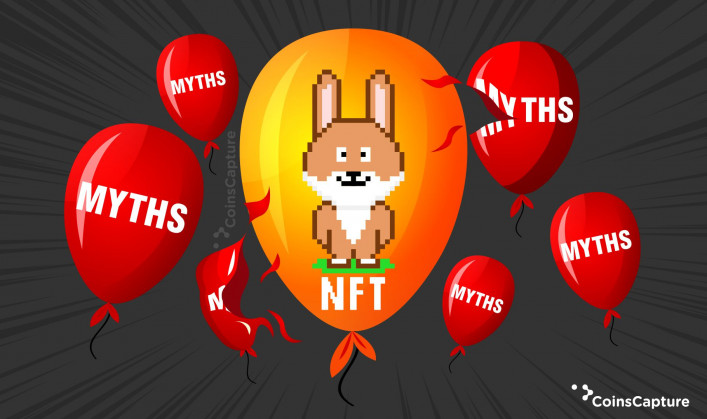7 November 2025
4 Popular NFT Myths Debunked
Initially, only a small number of individuals were aware of these blockchain-based Cryptographic assets, or NFTs. NFTs have grown in popularity since Jack Dorsey, the former CEO of Twitter, sold his first tweet on the NFT Marketplace for $2.9 million. Many people confuse these digital collectibles with Cryptocurrencies. But it is to be noted that NFTs are not Cryptocurrencies, as they can not be used for commercial transactions.
Before we begin debunking myths, let us understand that most NFTs are kept on the Ethereum blockchain, the only blockchain that can handle them. Minting and trading of NFTs are also supported by Zilliqa, Flow, Tezos, Solana, Terra, Cardano, and the recently rebranded BNB Chain. Here’s a list of some common myths before trading or purchasing NFTs:
1. NFTs are a Kind of Cryptocurrency
The most common misconception among people regarding NFTs is that they are a type of Cryptocurrency, which is incorrect. Blockchains are utilized for both Cryptocurrencies and NFTs, but the key differentiator is fungibility. Cryptocurrencies are fungible, which means they can only be replaced with another Cryptocurrency of the same price. NFTs, on the other hand, are non-fungible since each item is distinct and, as a result, they cannot be swapped.
Also read:Top 5 NFT Influencers On Twitter
2. NFTs are all Digital Art
NFT artworks are currently driving the discourse in the mainstream media, mostly due to Beeple. Keep in mind that the NFT does not save any data on the blockchain. It's the NFT, in the case of Ethereum, the ERC-721 token, which is stored on the blockchain. It refers to an asset that exists outside of the blockchain in this situation. For example, if we elect to store our identification data, such as passport details, as NFTs one day, the passport data itself would not be published on the blockchain as a token.
3. NFTs are harmful to the Environment
NFTs utilize blockchain technology, which employs Proof-of-Work (PoW) protocols, which has led to the idea that its implementation is environmentally hazardous. In reality, today's NFTs make use of blockchain technology, which is based on the Proof-of-Stake (PoS) protocol. The PoS strategy is also more power effective than the PoW technique.
Bitcoin and Ethereum, both PoW blockchain systems, account for a modest portion of total blockchain activity. More sustainability is being advocated for by the blockchain business and NFT musicians. Other approaches have been proposed, such as "off-chain" transactions, the use of renewable energy, and less energy-intensive blockchains such as Algorand and Tezos. NFTs can greatly lessen their environmental effect by using these strategies.
Also read: 10 Affordable NFT Projects For 2022
4. NFTs don’t have Value
One of the most common misconceptions regarding NFT is that it is worthless. NFTs offer unique advantages to their owners. For individuals who purchased Gary Vee's first NFT collection, unique offers such as meals with Vee, basketball games, and one-on-one chats with him were included. NFTs have their own set of abilities that only its owner has access to.
The Bottomline
NFT is a new technology with enormous promise and opportunity for growth; instead of focusing on NFT flaws, focusing on what they solve and how they may be enhanced further will be more effective and beneficial. Last but not least, NFTs are here to remain. Numerous businesses, ranging from the arts and media to education and ticketing, have already begun to see the potential of NFTs and apply them to create new opportunities. If you want to keep up to date, there are several places on the Web where you may learn more about NFTs.
Disclaimer - The author’s thoughts and comments are solely for educational reasons and informative purposes only. They do not represent financial, investment, or other advice.






